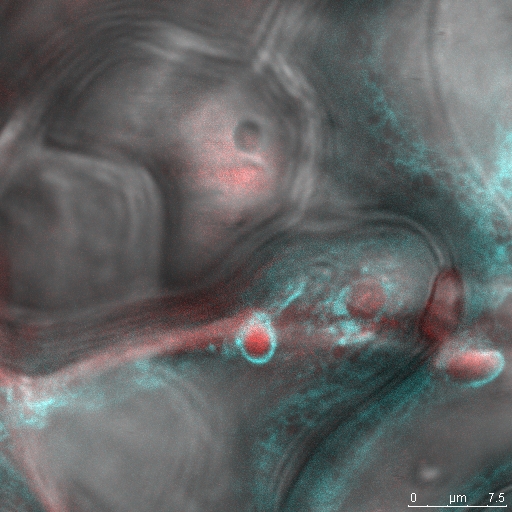Sciencepic of the day: Phytophthora haustoria in plant cells
In today's post, I will share an image that I took when I was still a postdoc. It is a confocal microscopy image of the interaction between two transgenic organisms: Nicotiana benthamiana and Phytophthora capsici. P. capsici loves infecting its plant host N. benthamiana (the plant doesn't to be fair).
In fact, many pathogens like to infect N. benthamiana, most notably, the natural genetic engineer Agrobacterium tumefaciens. I took advantage of this by doing the following:
1. Express an Endoplasmatic reticulum (ER) localized marker protein (Cyan Fluorescent protein or CFP) in N. benthamiana epidermal cells. I did this by ectopically expressing this protein through A. tumefaciens infiltration into leaf panels.
2. I took a transgenic P. capsici strain that expressed the red fluorescent protein TdTomato and used it to infect the leaf panels I prepared as described above.
3. I waited 48 hours and then used confocal microscopy to image plant cells (seen as these puzzle shapes) that were being infected by P. capsici. For this, I used three channels: 1-TdTomato (red), CFP (cyan colored) and bright field.

Confocal image of P. capsici infected N. benthamiana (Source: own collection)
OK, the image. What does it show? On the image, you can see how a red structure pushes into a 'balloon' colored in cyan. The balloon is the plant ER, labeled with the marker, pressed against the host cell membrane. The red structure is the pathogen (remember, it expresses TdTomato) and pushes into the host cell to make the balloon. Alternatively, it is pushing against the host cell without breaking it (similar to someone putting on a glove). This structure is called the haustorium and is a specialized "organ" that we now think is important for the interaction between host and pathogen. Mostly communication and exchange of molecules.
Why is this important?
Well, in the case of Phytophthora, haustorium formation is a critical step in infection. When this fails, infection stops or the disease cycle cannot be completed (Avrova et al., 2008). The formation of the haustorium and establishment of infection is, therefore, a stage that is targeted by plants. We know plants do this by deploying receptors that can detect effectors that are secreted from the haustorium into host cells (see my recent posts on this).
Reference:
Avrova, A. O., Boevink, P. C., Young, V., Grenville‐Briggs, L. J., Van West, P., Birch, P. R., & Whisson, S. C. (2008). A novel Phytophthora infestans haustorium‐specific membrane protein is required for infection of potato. Cellular microbiology, 10(11), 2271-2284.
I hope you will find these pieces interesting. Your vote and follow help me open up the exciting world of plant biology and pathology to you.
Thank you @foundation for this fantastic SteemSTEM gif
